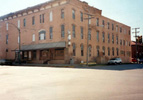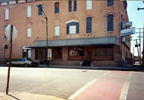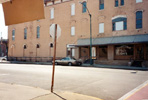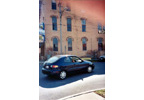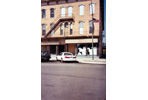DeWitt County Today
Many old buildings, homesteads and such have been renovated and are now displayed, or open to the public to view. For those of you that have gathered information on your family genealogy and are planning a trip to the town/county that your family members once lived, it might be nice to know what is there to make your trip more comfortable and informative.
Anyone that would like to list a place with a historical past, please e-mail the information, and I will post it here. As usual, please be sure to put your name and e-mail address in your message. Also, be sure to put DeWITT COUNTY TODAY in the subject line.
The First National Bank and Trust Company
The First National Bank and Trust Company was granted its original charter on Jan. 20, 1872 under the name of the DeWitt County Nation Bank, and was the first nationally chartered bank in DeWitt Co.
The bank was founded with the investments of 10 stockholders, the principal stockholders being: W.R. Carle, J.T. Snell, and Col Thomas Snell, Mr. Carle, the first president of the bank, came to Wapella from Pennsylvania and prospered in the grain business. Joseph J. Kelley was the Bank's first cashier.
J.T. Snell succeeded W.R. Carle as president in 1875 and served until his son, Richard, was named president in 1897. Richard Snell served until 1936, when Thomas Snell Dinsmore, great grandson of the founder, was named president of the bank until his retirement in 1960. Mr. Dinsmore sold the bank to an out-of state firm. Herb Cunningham was the next president, succeeded by Jack Wells. A bank holding company from Joliet purchased the DeWitt county National Bank in 1972 and Donald Evans became president.
In 1974, the name of the bank was changed to First National Bank and Trust Company to reflect the addition of the trust department.
First National Bank and Trust Company's building has been remodeled several times. Although the Bank occupies the same site as in 1872, it is nearly twice as large as its original structure.
The Clifton H. Moore Homestead
The Clifton H. Moore Homestead "A WALK into HISTORY" This is a "Must See". One block east of Business Route 51 at the north edge of Clinton, IL. Open 10:00 a.m. to 5:00 p.m. Tuesday through Saturday and 1:00 p.m. to 5:00 p.m. on Sunday, April through December. Closed on Mondays and Holidays. Houses the DeWitt County Museum, the formal address being: 219 East Woodlawn, Clinton, Illinois 61727 (217) 935-6066. This is a lovely restored Victorian mansion listed in the National Register of Historic Places with 3 buildings of antique farm machinery. It is also home of the “Apple ‘N Pork Festival", held in September.
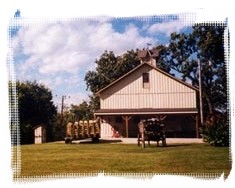

A Delightful Journey into the Mid Victorian Past
Construction was started on the C.H. Moore Homestead in 1863 by John and Minerva Moore Bishop. Mr. Bishop was a prosperous grain and lumber dealer in Clinton. Work on the C.H. Moore Homestead was completed in 1867 after the Civil War had ended and life took on a more normal pattern. Soon after this the Bishop's only child died. After Minerva Bishop's death in the early 1880's, Mr. Bishop sold the house to his brother-in-law, Clifton H. Moore. The Honorable Clifton H. Moore, Clinton's first resident attorney, had many influential friends. He and Abraham Lincoln often served as co - council in court cases held in DeWitt County. The mansion became the focal point of hospitality to Jesse Fell, Asahel Gridley and other illustrious people of the day. David Davis often visited the C.H. Moore Homestead. He was supreme court justice during the Lincoln administration.
Unique Library
The west wing of the home was added in 1887 to house Mr. Moore's vast collection of books. At the time of his death, he owned approximately 7,000 volumes. The two-story high library has a vaulted ceiling and stenciled walls. There are four season windows on the upper level, and an iron railing around the suspended upper gallery. The furniture and paintings include many of the original Moore furnishings.
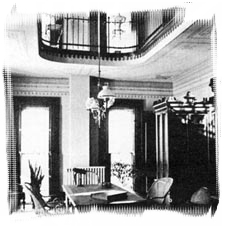
As you tour the mansion, step back 100 years and for a little while become a part of the gracious Victorian Era.
In overall appearance the structure is vaguely Italianate. But some design elements, such as the modest central pavilion and the low, straight sided mansard roof with dormers, point toward the newly fashionable Second Empire school of domestic architecture. A shallow slender columned veranda extends the length of the original south facade. The interior reflects the general simplicity of an early Victorian design with a French influence. The woodwork is without any trim or carving. The rooms are compactly arranged with high ceilings, tall shuttered windows, handsome ceiling medallions and carved, white marble fireplaces.
Front Parlor
The formal front parlor depicts the Victorian era at its most elegant. The graceful Italian inlaid design table and matching pier mirror are original to the house.

Back Parlor
This room, sometimes called the "morning room," was used by the lady of the house to meet with servants and to plan the day's activities. The rose and ecru color scheme gives it unusual warmth and charm.
Delightful Child's Room
Furniture and toys of the era are on display here, including several prized dolls. The rare, child size four-poster bed, dates from early 1800's. It is similar to one displayed at Mount Vernon in Virginia. A pastel portrait of Mary Ann, the original owners' only child, enhances this room.
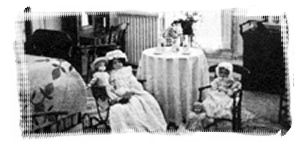
Doll Collection
Many of the precious old dolls from the Museum's permanent collection are shown in the upstairs hall. There are German, French, bisque, fashion, china and many other types of dolls displayed.
Restored 1880 Kitchen
A cozy room with mellow, blue gray patterned wallpaper, well worn furnishings and an iron, Lincoln style light fixture. The charming old red cupboard has bins for flour and sugar and drawers for sweet smelling spices. The kitchen "safe" is ready to receive pies, cakes and foods fresh baked for the family.
Hospitable Dining Room
A massive Renaissance extension table and marble topped sideboard both elaborately carved dominate the room. The colorful wallpaper, made in France, is a typical Victorian pattern. The parquet floor is fitted with white oak, birch, walnut, maple and cherry.
Music Room
It is decorated in Victorian Red and carpeted in authentic 24 inch wide strips. The fringed and elaborately draped window hangings are made of rich, imported French brocade. Cut glass prisms sparkle on the antique chandelier. The Moore's huge Steinway grand piano is the focal point of the room.
Mahogany Bedroom
The lovely old master bedroom is complete with mahogany bed, dresser, marble top washstand and the original, tall, shuttered windows. The beautifully restored plaster medallion of the high ceiling compliments the swag design of the mid Victorian blue and old rose wallpaper.
Walnut Bedroom
An oil painting of Mr. Moore's daughter, Winifred, hangs over the marble fireplace. The impressive Renaissance bedroom suite, with rare matching single beds and typical floral wallpaper, make a refined and comfortable room.
Basement Displays
These displays are housed in the original dirt floored basement which has been renovated for this purpose.
The Kent Museum
The Kent Room contains a wealth of memorabilia including a chronicle of the early history of DeWitt County, a collection of World War I weapons and many Indian artifacts. Items from all over the world are included in the display. Historical pictures line the lower level hall and represent moments of history to be pondered and remembered.
The Prairie Room
A single room depicting an early log cabin in DeWitt County and devoted to the furnishings used by early settlers during the 19th century. A necessity for this early living quarters was the fireplace which was used for cooking as well as a source of heat during cold winters.
Display Room
Informative displays are housed in this room and are changed from time to time. This area provides a means of displaying the museum's varied collection of historical items.
Shop at the Museum Gift Shop
It has a real "country" look. There are appealing handcrafted and decorator gifts of wood, brass and cast iron and many items reminiscent of yesteryear. Come in and browse.
Taylor-Magill House
The Clinton City Council and the Magill House Restoration Committee are currently working to restore the now-vacant 134-year-old hotel and transform it into a tourist attraction. The hotel is listed on the National Register of Historic Places but has been empty for several years. After a series of owners failed to complete any improvements, the city of Clinton bought the building for $10,000 several years ago. The restoration endeavor is viewed by the City Council as a community project, not a city project. It is envisioned that one or more investors will control the hotel or that they can sell shares in the hotel and it will be owned by the citizens of Clinton.1,2,3
In 1847, Henry N. Taylor and Henry Bell bought the lot on which the Magill House now stands. In 1853, they moved their business concern, Taylor, Bell, & Co., from Ohio to Clinton and in 1854 they built a large, 3-story frame building on the lot. One night in the winter of 1857/58, the building burned to the ground and the owners had no insurance. One half of the lot from the corner to Woodbine was eventually sold to the Magill brothers. Originally, they were proposing to build three buildings of two stories each. Due to the advent of the Gilman, Clinton, & Springfield Railroad, and at the urging of Clinton citizens, the Magill House was constructed between 1871 and 1872 by the Magill Brothers at a cost of $35,000. The Magill brothers invested $25,000.00, Clifton Moore $2,500.00, and the rest came from stock sold at $100.00 a share to the neighboring citizens and farmers.
The Magill House is a brick structure, three stories high, besides the basement, and covers half a block. The original floor plan included 45 large rooms, besides three storerooms on the first floor, a dining room, billiard room, hallways, and the basement. It is situated just north of the public square, fronting on Center Street and bordered by East Washington. The building was originally heated by hot air but this mode of heating was soon abandoned because the expense was too great for the income of the house.
For more information, read Taylor-Magill House - Historical Gleanings.
1The Pantagraph, Sept. 7, 2004.
2Clinton Daily Journal
Online, Aug.17.
3Clinton City Council Minutes from Aug. 18, 2003,
Sept. 2, 2003.
4History of DeWitt County, IL; W.R. Brinks & Co.,
1882; Philadelphia, PA.
Weldon Springs State Recreation Area
Weldon Springs State Recreation Area was originally purchased by Judge Lawrence Weldon before the Civil War. Judge Weldon leased the property to the Weldon Springs Company in 1900. Each summer from 1901 to 1921, area residents gathered at the site to hear public speakers and entertainers for ten days. The source of the water which flows from the natural springs can be traced to an ancient river that flowed through DeWitt County millions of years ago. For more information, read The History of Weldon Springs, by John Dawson. Chautauqua Days is held the last weekend in July. (217) 935-2644.
Clinton Lake State Park
Clinton Lake State Park is located on what was primarily prairie and bottomland forest before the arrival of settlers in the area in the 1830's. Before that, historians believe the area was the site of small villages and hunting camps of tribes of the Illiniwek. Construction of the 4,900-acre lake began in the 1970s. Activities include picnicking, hiking, camping, swimming, water skiing, boating, and hunting. (217) 935-8722.
DeWitt County Activities & Festivals:
Chatauqua Days (July-Weldon Springs, Clinton), Fourth of July Celebration (July-Farmer City, Weldon Springs, Clinton, Waynesville), DeWitt County Fair (July-Farmer City), Apple & Pork Festival (September-Clinton), Waynesville Celebration (September), Old Settlers Reunion (September-Kenney), DeWitt Labor Day Fair (September-DeWitt), Clinton Maydays (May-Clinton), Heritage Days (June-Farmer City).
DeWitt County Tourism:
Contact the Clinton Area Chamber of Commerce & Tourism Bureau at their toll-free phone number, 1-866-4-DeWitt (1-866-433-9488).
DeWitt County,
Illinois
DeWitt County Building
201 W. Washington St. Clinton, IL
61727

